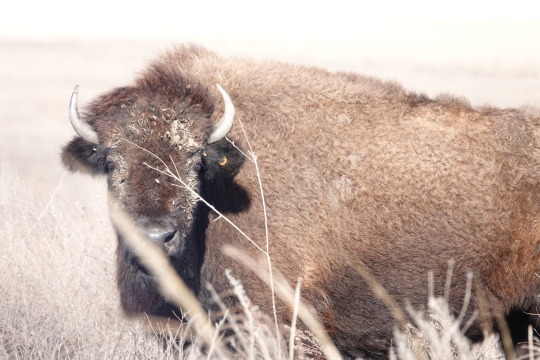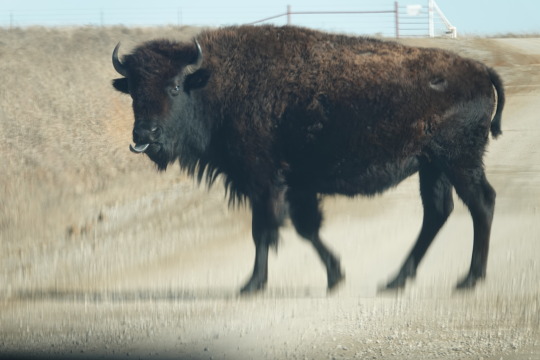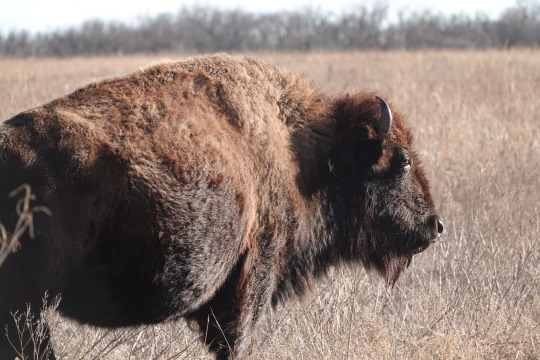#Tallgrass Prairie
Text
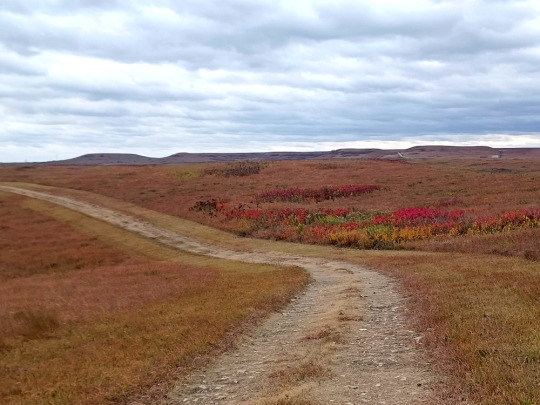

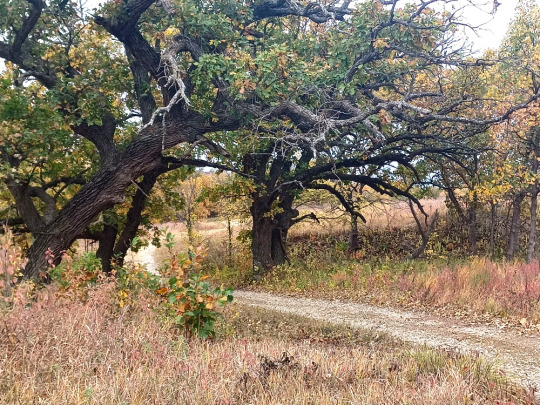
I am still decompressing from four days of driving, but I am intensely pleased that I got to spend a few hours walking the full six-mile loop at Konza Prairie Biological Station in the Flint Hills of eastern Kansas. I've been to plenty of old-growth forests, but this was my first time getting to explore an old-growth tallgrass prairie, and the oak groves that often form in low-lying areas. It was saved from being plowed under by all the dolomite stone just under the soil which made agriculture too difficult, other than cattle grazing. After driving for hours through cornfields and pastures full of non-native pasture grasses, it was such a relief to be able to immerse myself in a place that looks much like this entire landscape did for thousands of years. I know they're still doing restoration work there, since fire suppression has caused some imbalances, and of course the extermination of bison, but it's one of the best examples of North American tallgrass prairie still available today.
I have a lot more thoughts ruminating about this experience, but for now, enjoy a few pictures.
#Konza Prairie#tallgrass prairie#tallgrass#native ecosystems#old growth#prairie#grasslands#ecology#restoration ecology#Kansas#Midwest#North America#grass#grasses#nature#nature photography#travel
294 notes
·
View notes
Text

Summer storms, summer sunsets!
Photo: Illinois
#illinois#nature#midwest#sunset#summer#backyard photography#il#the prairie state#grasslands#tallgrass prairie#land of lincoln#after the storm
7 notes
·
View notes
Photo
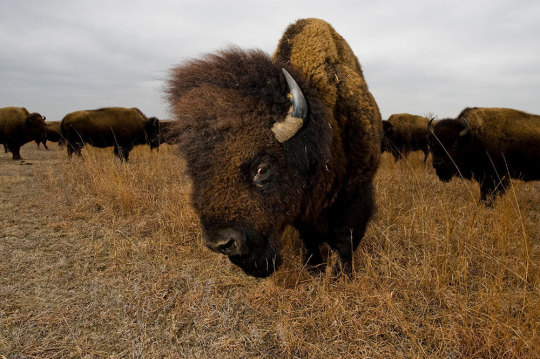
Wild American bison stand in the Maxwell State Game Preserve in Canton, Kansas. The state is also home to tallgrass prairie, a threatened ecosystem.
PHOTOGRAPH BY JOEL SARTORE, NAT GEO IMAGE COLLECTION
#joel sartore#photographer#national geographic#american bison#bison#animal#mammal#wildlife#maxwell state game preserve#canton#kansas#tallgrass prairie#nature#threatened ecosystem
36 notes
·
View notes
Text
Tulsa Day 3 Osage area
Today was a day out in Osage country seeing the tribal nations area and visiting the location of the film set "Killers of the Flower Moon". Initially our journey north into the region took us through several townships with native names and past many small nodding donkeys which reflect the areas oil industry. This was the background to the film released last year which documents the 1920s period of Osage history known as the Reign of Terror where native Indians were being killed to gain rights over their land and oil. We had already watched the film so Bob and Sally were taking us to Pawhuska, the location where the township of the film was based.
On our way into Pawhuska we saw a small museum signposted and decided to make a stop - what a gem! Not only did it tell of the oil in the area and of the Osage tribal chiefs and ways of t=life but for me the highlight was finding out that Pawhuska was the location for the very first Boys Scout troop in the USA. There were old documents, uniforms and some brilliant statues.
The story was that John Mitchell, who had been a chaplain to Baden Powell arrived in Pawhuska as a missionary in 1910, shortly after BP had founded scouting in UK and brought with him the ideas of scouting which he sold to both the parents and young people of the church. 19 young people enthusiastically formed a troop and scouting in USA was born. However, the Pawhuska troop didn't attend the incorporation ceremony for the Boys Scouts of America in Washington and another Troop was awarded the Charter as first. In 1956 Rev John Mitchell produced evidence of how the Pawhuska troop was organised and the BSA have now recognised Pawhuska as the first Troop.
Our next stop was lunch at The Pioneer Woman's Emporium in Pawhuska where we tried cheesy Grits and had a beef sandwich and salad, a lot less food than yesterday thankfully. Then it was a walk around the town to see the buildings used in the film then it was off to the Tallgrass Prairie Reserve.
The Prairies used to cover 14 states stretching from Canada to the south and over 142million acres of land. Now there is less than 4% of this area in only Kansas and Oklahoma. The Tallgrass Prairie reserve purchased 29,000 acres of ranch land in 1989 to recreate a functional tallgrass ecosystem using traditional methods including controlled burning and bison. Originally 300 bison were introduced and there are now 2300 or more bison and we got some lovely close up encounters.
Back in Tulsa we visited Bob and Sally's home for drinks and met Ryan and Liz, their son and his girlfriend (and Lucy the dog) and then it was out for our final meal with the family some sushi.
We have had an amazing time with Bob and Sally and its certainly set us up well for our travels.
Now its a question of trying to avoid the snow as we start to move west!
0 notes
Photo
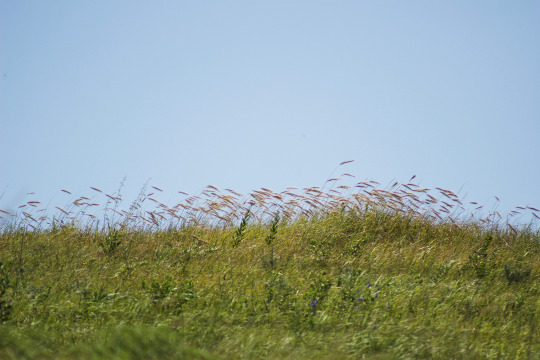

Grasses, and wildflowers, in the wind--appropriately at Tallgrass Prairie National Preserve, KS.
The wind was as close to incessant as I’ve ever felt, that summer on the plains.
R. Jake Wood, 2019.
1 note
·
View note
Text
my beloved enjoys sampling fragrances, and she recently got me a vial of this stuff called Cowboy Grass and, ground under my feet, it smells like my part of tx in a way that has me rolling around like a dog on carrion. it's so good.
#the musk deer im still mulling over but I haven't given it as many tries since I've been so enamoured with this one#it's like worn leather dried tobacco leaves and dry prairie grass in summer with the dust that clings to it#a lovely combination of empty barn and the tallgrass prairies fringed with scrub oak
6 notes
·
View notes
Text
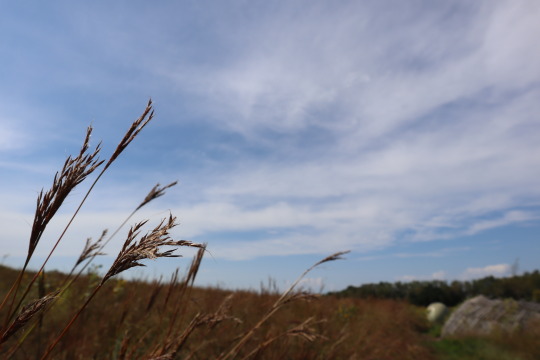

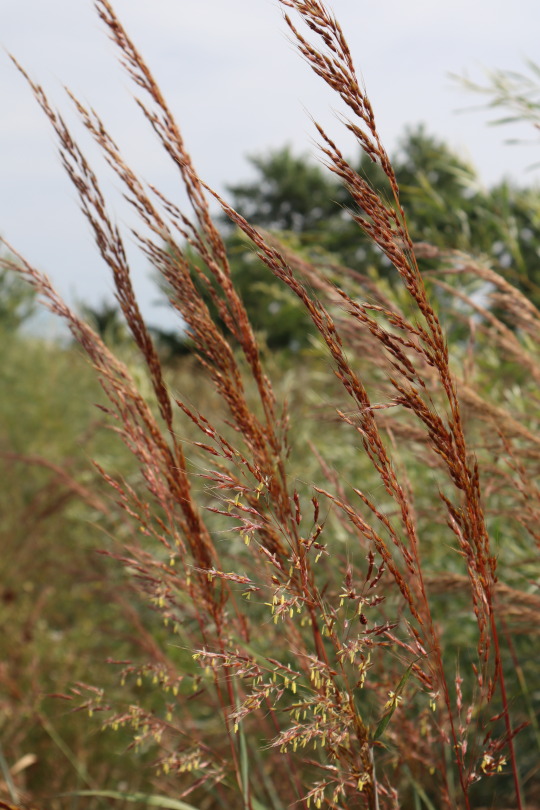


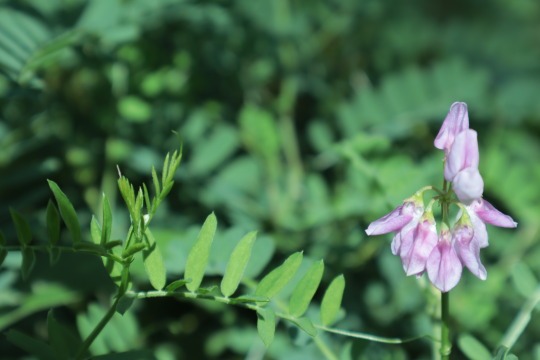
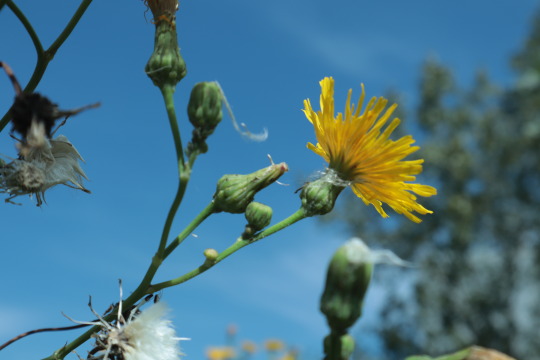
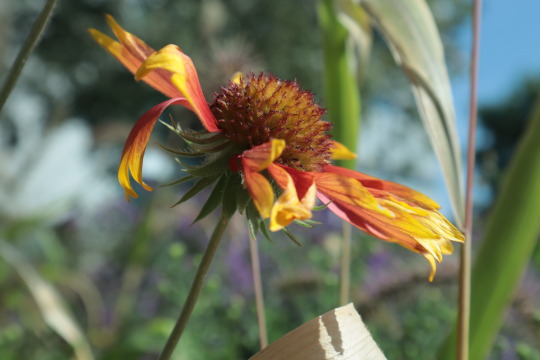
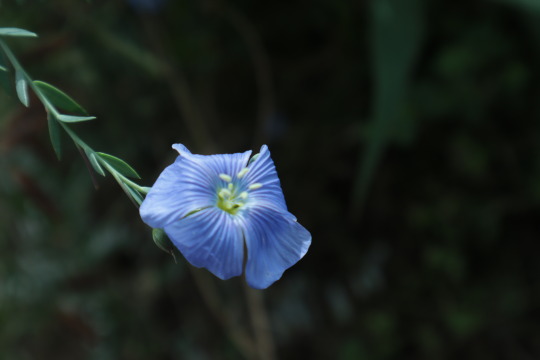
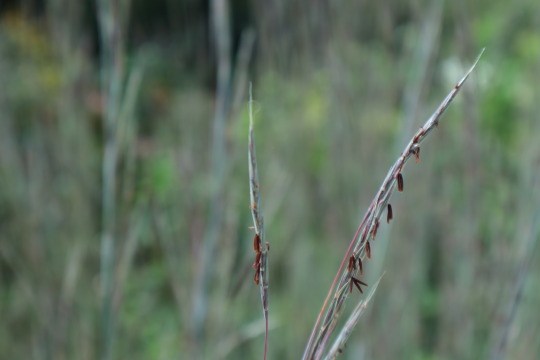
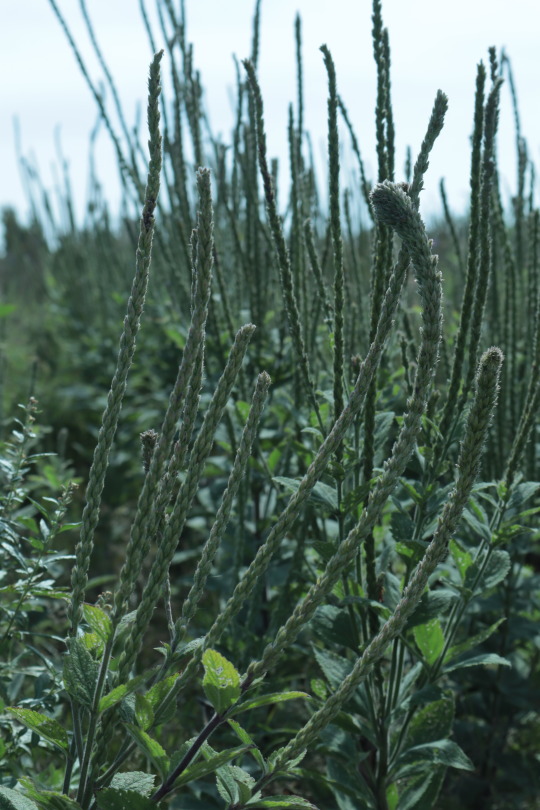


Went on a seed collecting/photography-long run today and had a great time!
Explored parc Frédéric Back for the first time and loved it, these prairies/flower meadows are absolutely beautiful and had no idea there was such a nice one in Montreal. Collected a bunch of seeds, took some nice pictures, and ran 21km, was a good day.
5 notes
·
View notes
Photo
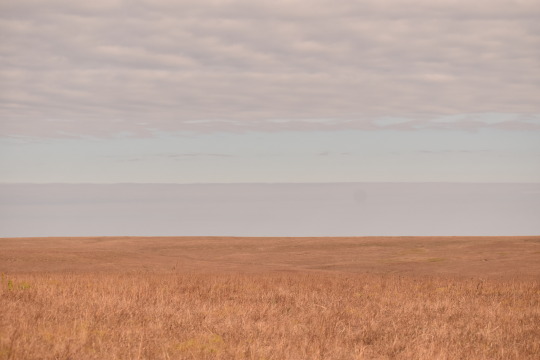
There ain’t nothin out there
7 notes
·
View notes
Link
Some photos. I hope this prairie and many others in the Midwest and the Great Plains are restored. Why? So we can enjoy our Earth as it was, marvel at it diversity, and protect ourselves from climate change. The prairie used to be 142 million acres. This Preserve in Oklahoma is 52,000 acres. Whenever I can, I saunter through the prairies in Illinois, usually with camera in hand and a lot of sunscreen, just staring, hearing, smelling, walking and pausing to snatch some photos. I’ve posted those photos for years on Tumblr.
Also, I note that the TallGrass Prairie Preserve is located in Osage County, Oklahoma. Reminds me of the Tracy Lett’s play, which premiered at the Steppenwolf Theater, in Chicago. It was called, “August, Osage County,” and its locale was Oklahoma. My spouse and I were one of the benefactors of the “Director’s Circle” at Steppenwolf, that funded the play. It went on to Broadway, and won several Tony Awards, then to London. It also won the Pulitzer for drama in 2008.
The movie was so-so, starring Meryl Streep, Julia Roberts, Chris Cooper, Benedict Cumberbatch, Ewan McGregor, Sam Shepard, and several others. I like the movie, but critics didn’t.
Here are some National Geographic photos of the Tallgrass Prairie Preserve. PS, baby bison are called “red dogs.” Look at them in the second photos, and you’ll understand.
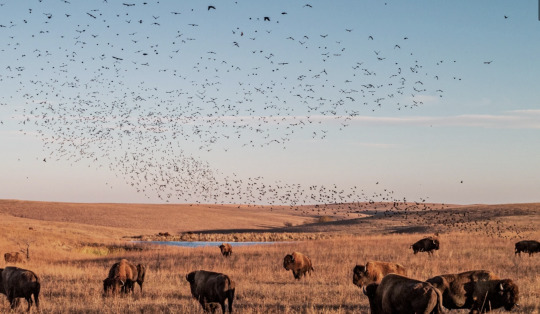
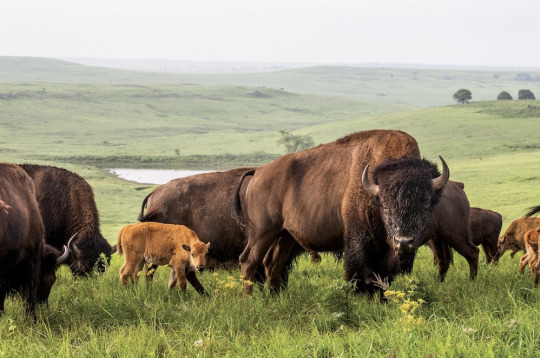
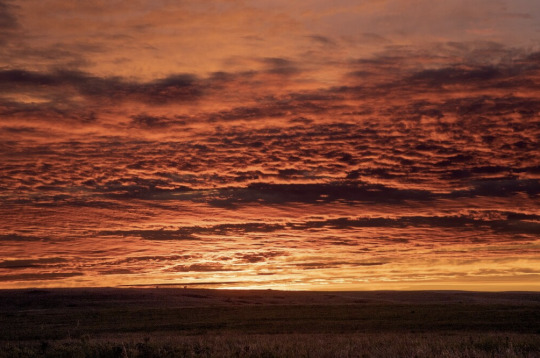
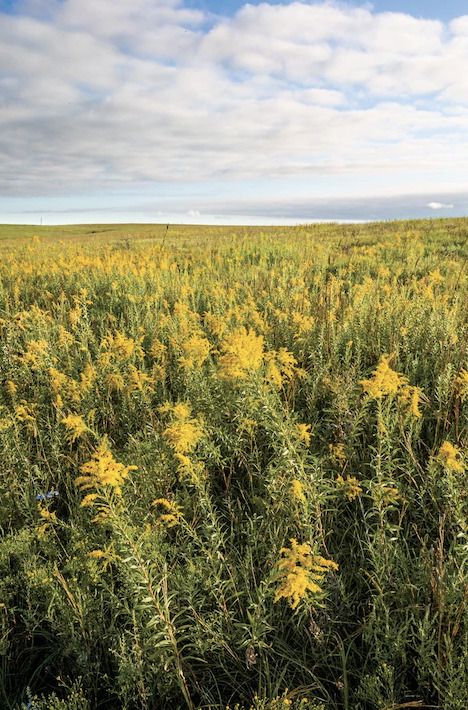
9 notes
·
View notes
Video
DSC_1823_Touch the Sky Northern Tallgrass Prairie Wildlife Preserve by Colin Overby
Via Flickr:
This is in the southern sector of "Touch the Sky", part of the Northern Tallgrass Prairie National Wildlife Preserve in Rock County, Minnesota. A beautiful place, a prairie full of rock outcroppings which makes it more interesting visually. A nice trail has been mowed through the grassland making access easy. N43 43.962, W96 17.233 Nikon D810, Nikon 14-24 2.8G @ F22 &14mm, 6 bracketed shots ranging from 1/15s to 1/3s, ISO 64. Processed in PS with the Nik suite of plugins. The Northern Tallgrass Prairie National Wildlife Refuge was established in 2000 to address the loss of America’s grasslands and the decline of grassland wildlife. Scientists estimate the original tallgrass prairie in Minnesota and Iowa covered about 25 million acres. Now, there are only about 300,000 acres left in the two states. The refuge was created to work with individuals, groups and government agencies to permanently preserve and restore some of the northern tallgrass prairie. The Northern Tallgrass Prairie National Wildlife Refuge encompasses all or part of 85 counties in western Minnesota and northwestern Iowa. The refuge’s long-term goal is to protect 77,000 acres through conservation easements and government ownership. Easements and purchased lands are managed or overseen by the refuge or wetland management district office covering the area where the lands are located. Today, the refuge includes 49 parcels of land totaling over 5,000 acres. Forty-one units are protected through conservation easements, totaling nearly 2,500 acres. The eight units owned by the refuge system total nearly 3,000 acres; these parcels include two units in Iowa (352 acres) and seven units in Minnesota (2,451 acres).
0 notes
Text
Absolutely no one:
Me: "Hey so did you know that the Midwest is largely Tallgrass Prairie land, and-"
0 notes
Text
Prairie Days
Originally posted on my website at https://rebeccalexa.com/prairie-days/.
I’m in the middle of my fall peregrinations, currently staying with family in the Missouri Ozarks as my base of operations while I do some exploring of the area, and get up to my preferred flavor of trouble. Which, of course, includes volunteering.

Ozark Rivers Audubon Nature Center
I actually got to do a little back home at Willapa National Wildlife Refuge right before I left town. They’re doing some coast meadow habitat restoration at the South Bay Unit, and so a whole pile of us showed up Wednesday before last to spend a few hours digging up invasive plants cropping up in some patches that had been intentionally planted with natives like early blue violet (Viola adunca), yarrow (Achillea millefolium), and pearly everlasting (Anaphalis margaritacea). I confess I didn’t get any pictures because I was A) pretty preoccupied with the upcoming trip, and B) nothing makes me zone out more than sitting with a trowel digging up weeds for hours at a time. By the time I get back the “nice” weather (aka warm and sunny) will likely be done for the year, but I’m hoping for more opportunities to get back out there.
But that certainly wasn’t the end of my habitat restoration efforts for the month.
For the past couple of years, every time I come into Rolla, MO I stop at the Ozark Rivers Audubon Nature Center to see if they have any upcoming stewardship activities. They’ve done a beautiful job of restoring the remnant tallgrass prairie and oak savanna there and protecting the oak-hickory forest and that surrounds them, but invasive plants being what they are there are always more to be removed as the seed bank keeps new generations popping up.
This time around we were out in the prairie/savanna area with a bunch of folks from the officer training program down at Ft. Leonard Wood just down the highway. The objective was to remove as much of the autumn olive (Elaeagnus umbellata) as possible; this invasive shrub with a silvery underside to its green leaves can quickly shade out native prairie plants, and doesn’t offer local wildlife nearly as much food. Prescribed burns help knock it back, but some more resilient specimens manage to resprout, and of course there’s that pernicious seed bank in the soil.

Autumn olive
Most of these were much too large to simply pull up, so the most effective way to get rid of them was to go out in teams of two. One person uses loppers to cut the plant down as close to the ground as possible, and the other immediately dabs herbicide on the fresh stump, which then kills the roots and keeps the plant from regenerating. It’s a minimal use of the product when compared to spraying wide areas of foliage, and only treating the stump with a quick, targeted dab minimizes the chance of accidentally affecting surrounding native species. And since it doesn’t cause disturbance to the soil like digging would it’s less likely to stir up seeds that would then be even more likely to sprout.
I know herbicides are super controversial–they’re not my favorite thing either. But as I wrote in my chapbook Habitat Restoration: What It Is, Why It’s Important, and How to Get Started, judicious and careful use in habitat restoration is one of the few times I’m okay with it, and it’s about the only way to reliably get rid of some invasive plants permanently. Given that invasive species removal is one of THE best ways to make an ecosystem more resilient in the face of climate change, habitat restoration has to be a big priority now and going forward. While I am not ignorant of the environmental impact of routine overuse of herbicides in agriculture and yards alike, the targeted use of them in habitat restoration is definitely a “lesser of two evils” situation that deserves more nuance.
While autumn olive was the main target, we also managed to remove a few other pernicious invasives. Callery pear (Pyrus calleryana) was easy to spot with its leaves still bright green amid the various browns, golds, and reds of native vegetation. We also got rid of some privet (Ligustrum spp.), and a little Japanese honeysuckle (Lonicera japonica) winding its way through the meadow. While there’s still plenty to go around for the next volunteer crew, we did make a big dent in that area.

New England aster
It wasn’t just the invasive species in evidence, though; there were plenty of native plants to enjoy along the way. One of the most prominent was field goldenrod (Solidago nemoralis nemoralis), and while some had gone to seed others still had a touch of yellow. There was a splash of purple here and there from New England aster (Symphyotrichum novae-angliae), and delicate white snakeroot (Ageratina altissima) edged the treeline. Amid inland oats (Chasmanthium latifolium) and other native grasses, young northern red oaks (Quercus rubra) and white oak (Quercus alba) added splashes of scarlet. It was incredibly peaceful to be immersed in these beautiful species and more.
At a time when it’s all too easy to feel overwhelmed by the enormity of environmental devastation on multiple fronts, there is something empowering about getting my hands in the dirt, so to speak. No, removing some invasive shrubs from one remnant prairie won’t save the whole world. But it helps that ecosystem become more resilient, and gives the native species there a better chance. It also makes that place a better illustration of the grasslands that were much more common in this portion of the Midwest, and is an important reminder that it wasn’t always cornfields and cattle pastures.

Yarrow
On a microcosmic level, I just feel better after spending a few hours doing a little something good in the world. I felt better walking away knowing that native plants like this young yarrow I found beneath an autumn olive we removed will be more likely to thrive in the years ahead. I’ve absorbed some of the beneficial effects of being outside, too, and gotten a good bit of exercise at my own pace. And it’s good social time, too, in a setting that feels pretty darn comfortable, and we’re all united by a common interest in that moment. This is likely my last outdoor volunteer time of the year, but it was a great note to wrap things up on.
Did you enjoy this post? Consider taking one of my online foraging and natural history classes or hiring me for a guided nature tour, checking out my other articles, or picking up a paperback or ebook I’ve written! You can even buy me a coffee here!
#habitat restoration#invasive plants#invasive species#gardening#restoration ecology#ecology#herbicides#nature#environment#conservation#Missouri#Ozarks#prairie#tallgrass prairie#oak trees#oak#forest#wildflowers
34 notes
·
View notes
Photo

Tallgrass National Prairie, Kansas, September 2020
0 notes
Text
Kansas: Top 5 Places to Visit in Kansas, CA
Kansas: Top 5 Places to Visit in Kansas, CA
Kansas
Kansas is a place where you can experience a different slice of Americana. The state is known for its sunflowers but there’s more to it than that. It has a wide range of landscapes including hills, forests, grasslands, sand dunes and hills. There are many large, well-maintained towns. Here are some of the best attractions in Kansas. These attractions are worth a visit if you’re looking…

View On WordPress
1 note
·
View note
Photo
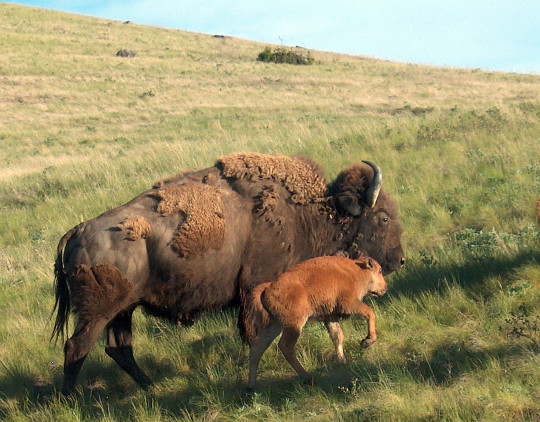
Kansas Research Shows Reintroducing Bison on Tallgrass Prairie Doubles Plant Diversity
Findings from decades of data also point to resistance to extreme drought.
Decades of research led by scientists at Kansas State University offered evidence reintroducing bison to roam the tallgrass prairie gradually doubled plant diversity and improved resilience to extreme drought.
Gains documented in the journal Proceedings of the National Academy of Science were among the largest recorded globally in terms of species richness on grazing grasslands. The research involved more than 30 years of data collected at the Konza Prairie Biological Station near Manhattan.
Zak Ratajczak, lead researcher and assistant professor of biology at Kansas State, said removal of nearly all bison from the prairie occurred before establishment of quantitative records. That meant effects of removing the dominant grazer were largely unknown, he said.
“Bison were an integral part of North American grasslands before they were abruptly removed from over 99% of the Great Plains,” Ratajczak said...
Read more: https://www.agriculture.com/news/business/kansas-research-shows-reintroducing-bison-on-tallgrass-prairie-doubles-plant-diversity
#bison#prairie#ecology#prairie ecology#grasslands#nature#science#ungulate#grazing#animals#north america#biodiversity#environment#conservation#restoration ecology#range ecology
1K notes
·
View notes
